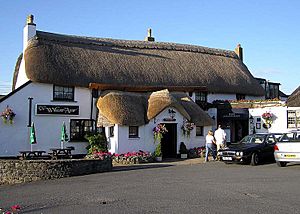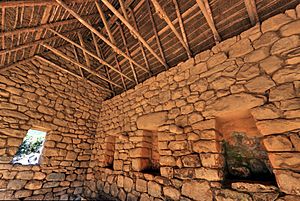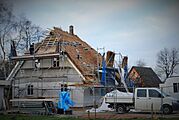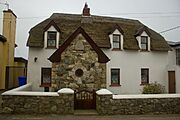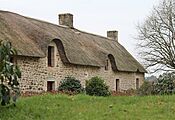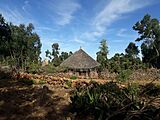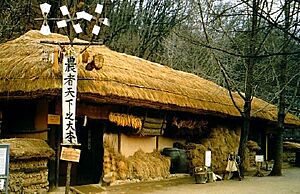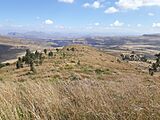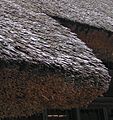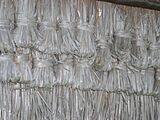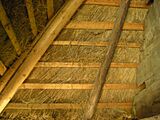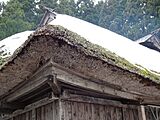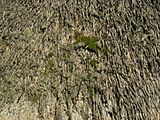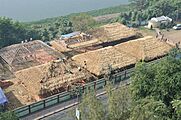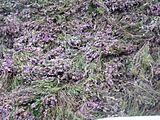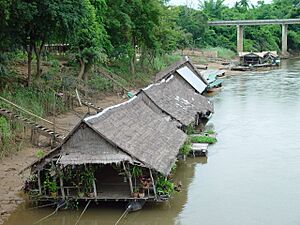Thatching facts for kids
Thatching is a special way of building a roof using dry plants. These plants can be straw, water reed, or even palm branches. The plants are layered carefully to make sure water runs off the roof. This keeps the inside of the building dry.
Because the plants are packed tightly, they trap air. This makes thatched roofs great for insulation. They keep buildings warm in winter and cool in summer. Thatching is a very old method of roofing. People have used it in both warm and cool parts of the world for thousands of years.
Today, thatching is still common in many countries. It often uses plants found nearby, which makes it affordable. In some richer countries, people choose thatched roofs for their homes. They like the natural look, or they want a roof that is better for the environment.
Contents
History of Thatched Roofs
People have been building with thatch for a very long time. The skills and methods were often passed down through families. We have many old records from Europe that describe how thatch was used.
In warm, equatorial countries, thatch is a main material for roofs and even walls. For example, in ancient Hawaii, people made shelters from ti leaves or pili grass. In Fiji, people use fan palm leaves for roofs. In Bali, Indonesia, black fibers from the sugar palm are used. These are called ijuk and are often seen on temple roofs.
Early Europeans likely used wild plants like water reed and heather for their shelters. Later, when people started farming, they probably used straw from cereal plants.
Many indigenous people of the Americas, like the ancient Maya and Inca, lived in thatched buildings. You can still see thatched homes in rural areas of Mexico and other parts of Latin America. These homes look very similar to those built by their ancestors.
In England, thatch was the main roofing material for most people until the late 1800s. Then, new ways to transport materials like slate became available. This made other roofing options easier to get. By 2013, there were about 60,000 thatched homes in the UK.
For a while, having a thatched roof was seen as a sign of poverty. But in the last 30 years, thatch has become popular again. Now, it is often a sign of wealth! People are interested in preserving old buildings and using materials that are good for the planet. There are about 1,000 full-time thatchers working in the UK today.
-
Thatch work on a house in Mecklenburg, Germany.
-
Thatched cottages in the sand dunes, Denmark.
-
Thatched roof house in Kilmore Quay, Ireland.
-
Thatched roofs in Kerene, Ethiopia.
Materials for Thatching
Thatching is popular in countries like the United Kingdom, Germany, and the Netherlands. The UK has over 60,000 thatched roofs, and the Netherlands has more than 150,000.
A well-made straw thatch roof can last over 50 years. Traditionally, new layers of straw were simply added over old ones. This created very thick roofs, sometimes over 2 meters deep! In Southern England, over 250 roofs still have base layers of thatch that are more than 500 years old. These old roofs show us what materials were used long ago. Most of them used wheat, rye, or a mix of both. Medieval wheat grew very tall, making good straw for roofs and grain for bread.
Changes in farming affected thatching. After the 1930s, new machines and shorter wheat plants meant less good quality straw was available. But since the 1980s, farmers have started growing older, tall wheat varieties again. This has improved the quality of thatching straw.
Water reed is another common material. It is often used in a single layer. Weathered reed is usually removed and replaced. Most of the water reed used in the UK today comes from other countries like Turkey and China. A water reed roof can last 40 years or more, especially on a steep roof in a dry area. The lifespan also depends on the thatcher's skill and the local weather.
In places where palm trees are common, palm leaves are used for roofs and walls. Many palm trees are even called "thatch palm." In the southeastern United States, Native American and pioneer homes used palmetto leaves. The chickees of the Seminole people still use palmetto leaves. In East Africa, coconut palm leaves are used for Makuti thatching.
-
A thatched roof made of ijuk (black sugar palm fibers) at Besakih, Bali.
Keeping Thatched Roofs Healthy
Thatched roofs need regular care. In the UK, the top part of the roof, called the ridge, usually needs replacing every 12 to 15 years. The whole roof needs to be re-thatched when the parts that hold the thatch in place start to show.
Moss can grow on thatch, but it's usually not a problem. In fact, some types of moss can even protect the roof. Over time, the top layer of thatch wears away and blows off. A roof needs replacing when the wooden sticks and twisted hazel staples that hold each layer become visible. The quality of the thatcher's work is very important for how long a roof lasts.
Is Thatch Flammable?
Many people think thatched roofs catch fire easily, but this is not always true. Thatch burns slowly, like a closed book. Most fires in thatched homes start from wood burners or faulty chimneys. Sparks from the chimney can ignite dry thatch around it.
To prevent fires, chimneys must be in good condition. It's also important not to burn anything that could send sparks up the chimney. Spark arrestors are usually not helpful because they can get blocked. All thatched roofs should have smoke detectors in the roof space for safety. Special fire-retardant sprays can also help slow down a fire.
For new buildings, a strong fire-resistant layer can be put under the thatch. This makes the thatch a "sacrificial" layer, meaning it would burn first, protecting the house structure.
How Thatch Performs
The way a thatched roof performs depends on many things. These include the roof's shape, how steep it is, where the building is located, the quality of the materials, and the skill of the thatcher.
Good Things About Thatch
Thatch has many natural benefits. It naturally resists weather and does not soak up much water if it's well-maintained. The roof won't get much heavier when it rains. A roof that is steep (at least 50 degrees) helps water run off quickly.
Thatch is also a natural insulator. The air trapped inside keeps the building warm in winter and cool in summer. Thatch also handles strong winds very well when it's installed correctly.
Thatching materials are found all over the world, making it a common roofing choice. Because thatch is light, the roof structure underneath doesn't need as much timber. Thatch is also very flexible. It can cover unusual roof shapes easily. This means it can use recycled or natural materials that don't have to be perfect sizes.
Challenges with Thatch
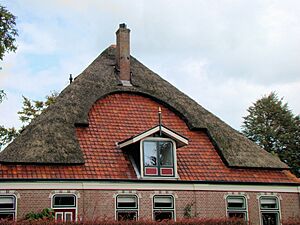
It can be harder to get insurance for thatched houses because of the idea that they are a fire risk. In the UK, about 50 to 80 thatched roofs catch fire each year. Thatching a roof takes a lot of work, so it can be more expensive than using slate or tiles. Birds might damage the roof looking for food, and rodents can be attracted to any leftover grain in straw.
In 1212, new thatched roofs were banned in London after a big fire. Existing roofs had to be plastered to reduce fire risk. The modern Globe Theatre in London has a thatched roof, but it's mostly for looks. It sits over a waterproof roof made with modern materials. The original Globe Theatre burned down in 1613 when a special effects cannon set the thatch on fire.
Some people think thatch can't handle heavy snow. But like all roofs, this depends on the roof's strength and steepness. Thatch is lighter than most other roofing materials. If a lot of snow builds up on a lightly built thatched roof, it could collapse. Most thatched roofs are steep enough (45 to 55 degrees) to shed snow and water. In places with extreme snowfall, like parts of Japan, roofs are made even steeper.
Studying Old Thatched Roofs
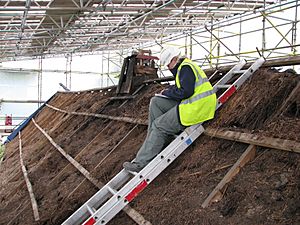

Some thatched roofs in the UK are very old. They hold clues about traditional materials and methods that were thought to be lost. In northern Britain, these old layers are often found under corrugated metal sheets. When old rural properties are being worked on, these layers often appear. Researchers have studied these roofs and found many different materials. These include broom, heather, rushes, cereals, and even turf and clay. This shows that thatching varied a lot from one region to another.
Examples include the Moirlanich Longhouse in Killin, Scotland, which used rye, bracken, and turf. Sunnybrae Cottage in Pitlochry used rye, broom, and turf.
Examples of Thatched Buildings
- Attap dwelling, Southeast Asia
- Blackhouse, Scotland, Ireland
- Chickee, Seminole
- Palapa, Mexico
- Roundhouse (dwelling), Iron Age European
- Teitos e pallozas, Asturias and Galicia, Spain
- Historic Villages of Shirakawa-gō and Gokayama
- Shinmei-zukuri
- Normandy, Brittany, France
See also
- Dethatcher, for lawns
- Houses at Auvers, depiction in art
- Swiss cottage, Cahir Thatched cottage orné in Cahir, Ireland.
- Vernacular architecture
- Woodway House A thatched cob cottage orné in Devon, England.
- Withy A thatching material from willows
- The House of the Five Senses the largest thatch roof in the world in Kaatsheuvel, Netherlands
- Covering (construction)


